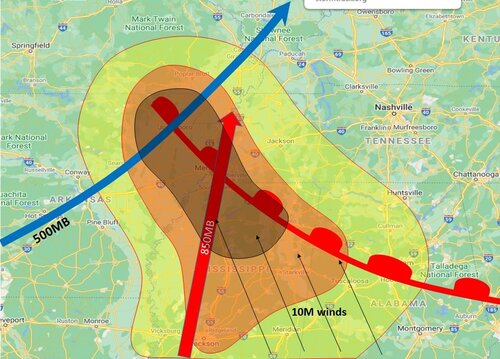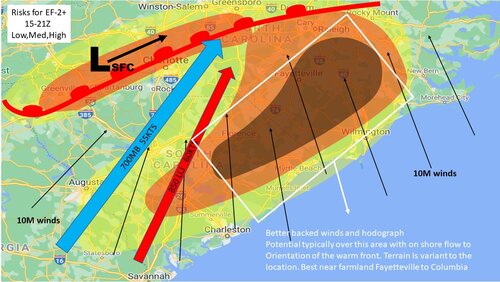Patrick K
EF0
Global models are in reasonable agreement of an upper low moving from near the OK panhandle toward the lower MO valley during the day on Wednesday. A warm front will push northward from central MS/AL toward the TN border by 20Z. A broad area of upper-60s dewpoints seems likely with instability building through the afternoon hours, although the warm sector appears to be mostly uncapped, particularly out ahead of the low. Shear, both bulk and directional, appear favorable for supercells across a wide area.
Given the lack of cap and strong instability, it looks like several rounds of initiation will occur, with the initial position of the warm front on Wednesday influenced by Tuesday night's storms across MS/AL/GA. The NAM3k depicts a round of storms moving from eastern AR into northwestern MS and into southwestern TN in the morning hours, crossing the warm front. A second round of initiation appears to follow in the wake of the early morning storms, along/invof the warm front in the early afternoon hours, around the Memphis area and MS/TN border, generally. The 20z-00z timeframe seems to be the real show, with supercells erupting in this timeframe across a broad swath of the warm sector into a highly destabilizing environment. Forecast soundings show long, clockwise veering hodographs with the LLJ ramping up out of the southeast into the evening hours, presumably maximizing the tornado risk around this time.
Question marks seem to be around warm front placement, cloud cover and ongoing precipitation affecting instability and storm timing, plus the lovely area that Dixie is for storm chasing. After chaser convergence on a narrow setup in the TX panhandle this weekend, it seems there will be much less chaser convergence for this broader setup, but also... trees, lot of trees.
I would target the Byhalia, MS area around lunch time and watch those presumed round of storms, with expectations to catch the early evening storms in that same area later in the day, keeping a close eye on the fine-scale details as they develop that afternoon.
Given the lack of cap and strong instability, it looks like several rounds of initiation will occur, with the initial position of the warm front on Wednesday influenced by Tuesday night's storms across MS/AL/GA. The NAM3k depicts a round of storms moving from eastern AR into northwestern MS and into southwestern TN in the morning hours, crossing the warm front. A second round of initiation appears to follow in the wake of the early morning storms, along/invof the warm front in the early afternoon hours, around the Memphis area and MS/TN border, generally. The 20z-00z timeframe seems to be the real show, with supercells erupting in this timeframe across a broad swath of the warm sector into a highly destabilizing environment. Forecast soundings show long, clockwise veering hodographs with the LLJ ramping up out of the southeast into the evening hours, presumably maximizing the tornado risk around this time.
Question marks seem to be around warm front placement, cloud cover and ongoing precipitation affecting instability and storm timing, plus the lovely area that Dixie is for storm chasing. After chaser convergence on a narrow setup in the TX panhandle this weekend, it seems there will be much less chaser convergence for this broader setup, but also... trees, lot of trees.
I would target the Byhalia, MS area around lunch time and watch those presumed round of storms, with expectations to catch the early evening storms in that same area later in the day, keeping a close eye on the fine-scale details as they develop that afternoon.


